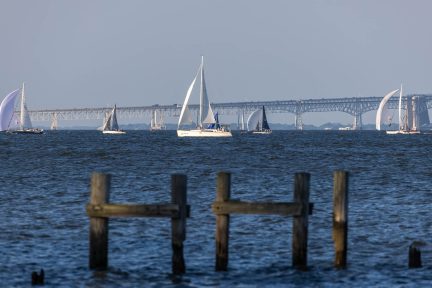Chesapeake Bay Program reports slight decline in underwater grass abundance
Chesapeake Bay Program reports slight decline in underwater grass abundance
In 2018, an estimated 91,559 acres of underwater grasses were mapped in the Chesapeake Bay and its tidal tributaries. While this acreage is less than the previous year, it is likely that substantially more submerged aquatic vegetation (SAV) grew in the Bay than the mapped acreage suggests: frequent rain, cloudy water and security restrictions prevented researchers from successfully collecting aerial imagery over the Potomac River near the Patuxent Air Base, as well as portions of the Susquehanna Flats, Mattaponi, Middle, Choptank and Honga rivers, and Fishing Bay (representing over 22% of the Chesapeake Bay and its tidal tributaries).
If we consider the acreage of grasses that these unmapped portions of the Bay supported in 2017, the estimated total for 2018 could be as high as 108,960 acres. This would be an increase from the previous total, which was the highest amount of underwater grasses ever recorded in the Bay since monitoring began over 30 years ago—breaking 100,000 acres for the first time.
Experts are encouraged by this news, as it’s likely that the actual expanse of underwater grasses in 2018 ranged between 91,559 and 108,960 acres. The growth and survival of underwater grasses are sensitive to the impacts that extreme weather conditions have on Bay water quality. In the past, underwater grass populations have taken several years to recover from the effects of hurricanes or high temperature events. With the record-breaking rainfall observed by most of the Chesapeake region in 2018, experts were concerned over how the grasses would fare: the persistence of underwater grasses seen last year suggests increasing resilience to such stresses, an indication that the restoration actions taken by the Chesapeake Bay Program and its many partners are working.
Experts attribute the presence of widgeon grass in the moderately and very salty regions of the Bay to be responsible for the steady underwater grass abundance. However, widgeon grass is a “boom and bust” species whose abundance can rise and fall sharply from year to year. A widgeon grass-dominated spike in one year can be a positive response to good conditions for growth and reproduction while survival between years is sensitive to changes in water quality such as conditions resulting from the impacts of extreme weather events.
Underwater grass abundance can vary from species to species and river to river. In 2018, local highlights included:
- Upper Central Chesapeake Bay: Approximately 272 acres of underwater grasses were observed throughout the upper central portion of the Chesapeake Bay in 2017, and in 2018, this figure rose to over 457 acres: an increase of 68%. Numerous species of grasses have been found in this area, including: widgeon grass, redhead grass, sago pondweed, horned pondweed, Eurasian watermilfoil, wild celery, common waterweed, curly pondweed, hydrilla and coontail.
- Patapsco River: The Patapsco River noted over 14 acres of grasses in 2017; in 2018, this figure rose to over 30 acres, an increase of approximately 114%. In the mid-2000s, local restoration projects in Shallow Creek at the mouth of the Patapsco River helped contribute to the increase of grasses, which continue to remain steady today.
- Upper Rappahannock River: In 2017, over 562 acres of grasses were mapped in the Upper Rappahannock River, and in 2018, that figure rose to 837 acres, an increase of over 48%. Researchers have found several types of grasses in this portion of the Rappahannock, including coontail, hydrilla, naiads, common waterweed and wild celery.
- Smith and Tangier Islands: Underwater grass abundance in Tangier Sound increased over 18% from 2017 to 2018. Over 21,504 acres of grasses were mapped in 2017, while approximately 25,340 acres were noted in 2018. The underwater grasses that stretch from Smith Island to Tangier Island make up the largest contiguous grass bed in the Bay. Widgeon grass dominates the area, but eelgrass can also be found.
Facts
In 2018, an estimated 91,559 acres of underwater grasses were mapped in the Chesapeake Bay and its tidal tributaries. However, 22% of this region was not fully mapped due to weather conditions, cloudy water and security restrictions. Using 2017 underwater grass abundance levels for these unmapped areas, it is estimated that the Chesapeake Bay and its tidal tributaries may have supported 108,960 acres of SAV in 2018, which would be a four percent increase from 2017 levels and a 59% achievement of the Chesapeake Bay Program’s 185,000-acre 2025 goal.
Tracking Bay Grass Abundance by Salinity Zone:
The slightly and moderately salty waters, as well as the fresh waters, were not fully mapped in 2018, which indicates a high probability that there were likely more acres of underwater grasses in those areas than actually measured. Using these estimates, experts believe that between 2017 and 2018:
- Bay grass abundance in the Bay’s fresh waters (the Tidal Fresh Salinity Zone) fell 891 acres (from 19,903 acres to 19,012 acres).
- Bay grass abundance in the Bay’s slightly salty waters (the Oligohaline Salinity Zone) fell 702 acres (from 8,389 acres to 7,687 acres).
- Bay grass abundance in the Bay’s moderately salty waters (the Mesohaline Salinity Zone) increased 2,931 acres (from 61,350 acres to 64,281 acres).
- Bay grass abundance in the Bay’s very salty waters (the Polyhaline Salinity Zone) rose 2,729 acres (from 15,251 acres to 17,980 acres).
Citizen scientists can now help scientists and managers track underwater grasses throughout the Bay. Chesapeake Bay SAV Watchers, the first official underwater grasses monitoring program for volunteers developed by the Chesapeake Bay Program, provides both individuals and organizations with an opportunity to participate in an engaging and educational experience in documenting the distribution and abundance of underwater grasses, while helping to generate useful data for scientists and managers. Visit https://www.chesapeakebaysavwatchers.com for more information.
Issues
Like grasses on land, underwater grasses need sunlight to survive. When the waters of the Chesapeake Bay become clouded with algae blooms or suspended sediment, sunlight cannot reach the bottom habitat where these grasses grow. While healthy grass beds can trap and absorb some nutrient and sediment pollution—thus improving water clarity where they grow—too much pollution can cause grass beds to die off. High water temperatures, turbulence from strong storms and drought can also affect the growth and survival of underwater plants. Chesapeake Bay Program partners are working to improve water clarity, protect and restore grass beds, enhance bay grass research and expand education and outreach to restore underwater grasses and boost their habitat benefits in the watershed.
Importance
Underwater grass beds are critical to the Chesapeake Bay ecosystem. They keep our waters clean by absorbing excess nutrients, trapping suspended sediment and slowing wave action that helps to stabilize shorelines, protect wetlands and reduce erosion. Bay grasses also offer food to small invertebrates and migratory waterfowl and shelter fish and blue crabs. In fact, bay grass abundance is one of several factors that can impact the health and stability of the blue crab population: the loss of these grasses is a loss of nursery habitat which can increase their vulnerability by pushing young crabs to gather in the limited nurseries that remain.
Earlier this month, the annual Blue Crab Advisory Report found that the overall Chesapeake Bay blue crab population is not depleted and is not being overfished. The report includes expert analysis of data from the annual Bay-wide winter dredge survey and harvest estimates from recent years. It is estimated that the overall blue crab population increased nearly 60% from 372 million in 2018 to 594 million in 2019. The commercial blue crab harvest increased about nine percent during the 2018 crabbing season, as commercial operations harvested approximately 59 million pounds of blue crabs from the Bay and its tidal tributaries. Recreational crabbers harvested roughly 3.4 million pounds in 2018, similar to the previous year.
Because bay grasses are sensitive to climate conditions and pollution but quick to respond to water quality improvements, their abundance is a good indicator of Bay health. To support the resurgence of underwater grass beds in the Bay, cities and towns can reduce polluted runoff and upgrade wastewater treatment plants with pollution-reducing technologies, farmers can use conservation practices to keep fertilizers in their fields, boaters can steer clear of bay grass beds that are growing in shallow waters, waterfront landowners can limit hardened shorelines where possible and homeowners can use rain barrels or rain gardens to slow the delivery of nutrient- and sediment-laden stormwater runoff into the Bay.
Quotes
“I’m so relieved to see that our SAV numbers didn’t decline dramatically in 2018. Last summer’s record rainfall—and the accompanying runoff and turbidity—definitely provided a stressful environment for our underwater grasses, but the fact that they had five solid years of expansion leading up to it helped the vast majority of the beds survive. They had gotten to a size and density that improved their resilience, which is what we were hoping for. Fluctuations in cover and abundance are totally natural, especially in response to varying weather conditions. What we need to do now is to double down on our efforts to decrease nutrient and sediment pollution and give our underwater grasses a chance to continue their recovery.”
- Brooke Landry, Natural Resources Biologist, Maryland Department of Natural Resources and Chair, Chesapeake Bay Program Submerged Aquatic Vegetation Workgroup
“We were all encouraged by the amount of SAV in the Bay in 2018 given the conditions they had to grow and survive in. But the real test is now, to see if the beds not only survived, but if they stored enough energy to support their continued growth.”
- Dr. Robert J. Orth, Professor, Virginia Institute of Marine Science
“Short-term fluctuations of bay grass populations are common. Over the past 30 years, the assessment of annual monitoring data shows a sustained long-term positive trend for underwater grasses on a Bay-wide scale. The trend reflects ecosystem resilience in response to progress made through the continued management actions taken by Chesapeake Bay Program partners throughout the watershed. We look forward to a full area assessment in 2019 to better understand the effects of the wet weather conditions during 2018 on our progress towards restoring bay grasses and meeting our long-term recovery goals for bay health.”
- Dr. Peter Tango, Chesapeake Bay Monitoring Coordinator, U.S. Geological Survey and Coordinator, Chesapeake Bay Program Scientific, Technical Assessment and Reporting Workgroup
“The continued, visible improvement in the overall health and abundance of Bay grasses shows us that our collective commitment to successful water quality programs are increasingly achieving positive results. Now in its 36th year, the Chesapeake Bay Program is more important than ever—ensuring that those practices at the vanguard of water quality improvement are replicated across the watershed. Every year, cities like Salisbury learn of new ways to minimize their impact upon the precious waters of the Bay and these initiatives benefit from our partnership with the Chesapeake Bay Program—an assertion that my fellow municipal leaders across the watershed can certainly echo.”
- Jake Day, Mayor, City of Salisbury, Maryland



